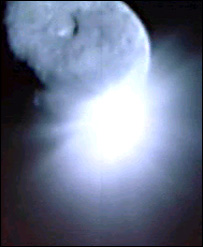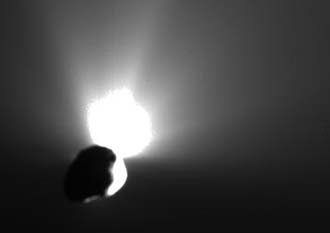British researchers watched the collision from telescopes at various sites in the world where the comet was visible at the time of the eruption (in England the sun had already risen). Among other things, British scientists were stationed in Hawaii, and the British Schmidt telescope in Australia. Many of the scientists are also involved in the European Rosetta project which is supposed to orbit and land a soft lander on a comet for the first time

As NASA flight controllers jumped and cheered in California when news of the success of Operation Deep Impact arrived this morning, efforts are moving from there to distant London. British space scientists have expressed satisfaction with the success of the American Deep Impact team. This is thanks to the huge amount of data that scientists hope will now flow from the collision.
British researchers watched the collision from telescopes at various sites in the world where the comet was visible at the time of the eruption (in England the sun had already risen). Among other things, British scientists were stationed in Hawaii, and the British Schmidt telescope in Australia. Many of the scientists are also involved in the European Rosetta project which is supposed to orbit and land a soft lander on a comet for the first time.
Deep Impact, the British scientists say, may provide valuable insight into the material expected to be encountered by the European spacecraft launched in February 2004 on a ten-year journey to comet 67P/Churyumov-Gerasimenko.
"Deep Impact is a beautiful preparation for Rosetta," said Dr. Andrew Coates of the Mollard Space Science Center at University College London.
Rosetta is not planned to crash into the comet, instead it will catch up with the comet in 2014 after passing by Earth, Mars and several asteroids several times and entering a three-year hibernation period. "Any addition to our knowledge of the surface of comets is important," said Dr. Coates.
Rosetta will launch a lander towards the CG surface. The lander will ring to anchor it to the comet's surface.
A soft landing is a difficult problem due to the low gravity of the comet nucleus. The lander, which weighs 100 kilograms on Earth, will weigh no more on the comet than a piece of paper.
If there is even a slight recoil, it will bounce like a rubber ball. To prevent this, the three legs of the landing gear are equipped with special shock absorbers suitable for glacial terrain, which is the layer on which you will land.
"One of the unknowns of the Rosetta mission is the internal structure of the core, how its components stick together and what is the strength of the materials." said Dr. Gerhard Schwehm, Rosetta Project Scientist. There is hope to learn now from Deep Ipamcapt. They will help us reduce the number of possible scenarios of the Rosetta lander landing on the comet nucleus."
However, even if they wanted to, the Rosetta crew members cannot make major changes to the lander, but a more extensive knowledge of the surface they land on will allow the mission scientists to check their models of the landing," said Dr. Shum.
The lander, named Philae, will determine the composition of the surface and what is beneath them by using spectroscopic equipment and examining the samples. It will also take high-resolution photos and carry a radar that will determine what the interior of the comet nucleus is made of.
One of the surprises in yesterday's collision was a larger-than-expected amount of material dug up by the Deep Impact projectile. It is estimated that the collision released in 15 minutes, an amount of material that the comet loses in a month. "It seems to me that this is material emitted from the comet for an entire year," commented Prof. John Zarnecki, a space scientist at the British Open University.
The scientists have already made initial interpretations of the data. First, the comet's shell is weaker than expected. Prof. Zaranki also says that they hypothesize that the material in the comet was probably brittle, like a brick. Dr. Coates compared it to compacted snow.
Dr. Shum said that he believes that the accumulation of gases just below the surface contributed to the large collision.
"When the material is shaken by the impactor, it is simply ejected." said. However, scientists allayed fears that the comet's trajectory had changed, possibly heading for a collision with Earth. "It was like a fly hitting a 747 plane, and crashing into one of the windows, explains Prof. Ivan Williams from Queen Mary University in London and a researcher in the Rosetta project.
"Although Temple-1 does not pose a threat to Earth, other comets have harmed us in the geological past. An asteroid or comet crash is cited as the cause of the extinction of the dinosaurs at the end of the Cretaceous. "65 million years ago, one of these things wiped out the dinosaurs," said Paul Roche, director of the Faulkes Telescope. "Now we pay them back."

One of the first images taken by the high-resolution camera of the Deep Impact spacecraft
